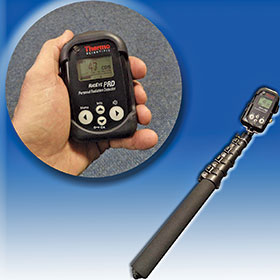How a new generation of miniaturised devices is changing the radiation detection industry
Technews Industry Guide: Maintenance, Reliability & Asset Optimisation 2018
Analytical Instrumentation & Environmental Monitoring

Exposure to harmful levels of radiation can easily be prevented with a new generation of ultra-small, wearable dosimeters. Less expensive, simpler to use, and portable, these devices boast the same levels of accuracy as their larger counterparts. In fact, miniaturisation is set to become one of the most important trends in the radiation detection market, estimated to become a $1,6 billion industry by 2020.
This growth is caused by falling costs in detection equipment, as well as factors like higher cancer rates, growing popularity of radiation therapy, and fears of nuclear terrorism. Global industry experts include the Middle East and Africa as one of the world’s top three fastest-growing regions. “Recent innovations in lightweight, wearable devices have dramatically reduced the cost of radiation detection, bringing devices within reach of new users,” notes Raymond Naidu, CEO of OEN Enterprises.
These smaller devices are perhaps the industry’s biggest advancement in recent years, in the fight against radiation exposure and contamination. They are capable of detecting alpha, beta, gamma or neutron radiation, sounding different types of alarms depending on the threat levels, and keeping accurate records of the levels detected.
“Mauritz van Niekerk, head of radiation at OEN explains that it is essential to select the right device for one’s needs. For example, while Thermo Scientific’s Electronic Personal Dosimeters, weighing only 95 grams, may be useful for most industries, the RadEye PRD would be required for a customs officer looking for hidden sources of radiation. At 160 grams, the more specialised RadEye PRD is up to 100 000 times more sensitive than typical electronic dosimeters.
These newer ranges of dosimeters capitalise on the power of Big Data. With their data recording and archiving features, users can closely track exposure, measured over periods of time, ensuring that exposure is within certain dose thresholds. South Africa’s National Nuclear Regulator pegs the safe radiation threshold at 20 millisieverts per year, averaged over the past five consecutive years.
“Above all,” notes Naidu, “radiation detection equipment must be 100% reliable. As with anything relating to personal safety, we advocate higher quality and longer lasting dosimeters, to give users the peace of mind that they are fully protected.”
For more information contact Mauritz van Niekerk, OEN Enterprises, +27 (0)11 675 4447, [email protected], www.oen.co.za
Further reading:
Ensuring clean and safe water
Endress+Hauser South Africa
Editor's Choice Analytical Instrumentation & Environmental Monitoring
Endress+Hauser’s comprehensive range of disinfection sensors is designed to monitor and control disinfectant levels in water treatment processes.
Read more...
High-precision measurement of insulating gases
WIKA Instruments
Analytical Instrumentation & Environmental Monitoring
WIKA has launched the next generation of its GA11 gas analyser. It enables switchgear operators, manufacturers and maintenance companies to record the quality of SF6 gas and alternative insulating gases.
Read more...
Say goodbye to missed contamination with real-time colour monitoring
Analytical Instrumentation & Environmental Monitoring
Applied Analytics offers seamless and rapid colour monitoring in processes with an industry-proven analyser that quickly and accurately monitors colour in your sample stream for impurities and inconsistencies.
Read more...
Metrology laboratory is the heart of data-driven production consistency
Analytical Instrumentation & Environmental Monitoring
Pressing and welding have been at the core of Tier 1 automotive supplier, Malben Engineering for 50 years; but it is the company’s investment in its state-of-the-art metrology laboratory which has set it apart.
Read more...
Unlocking precision: The future of inline concentration measurement
Analytical Instrumentation & Environmental Monitoring
[Sponsored] In today’s resource-conscious industrial world, manufacturers are under growing pressure to optimise productivity, ensure consistent product quality and minimise waste. One of the most effective levers for achieving these goals lies in mastering concentration measurement, and Anton Paar is redefining how it is done.
Read more...
High-precision measurement of insulating gases
WIKA Instruments
Analytical Instrumentation & Environmental Monitoring
WIKA has launched the next generation of its GA11 gas analyser. It enables switchgear operators, manufacturers and maintenance companies to record the quality of SF6 gas and alternative insulating gases.
Read more...
Smart sensors for cleaner, safer food and beverage processes
Instek Control
Analytical Instrumentation & Environmental Monitoring
Instek Control specialises in advanced measurement solutions tailored for the food, beverage, pharmaceutical and mining industries. Among the company’s offerings are advanced process sensors from Anderson-Negele, as well as ALVIM biofilm monitoring technology.
Read more...
Elevating mining separation processes through precision instrumentation
Endress+Hauser South Africa
Analytical Instrumentation & Environmental Monitoring
In mining operations, the quest for efficiency and productivity is key. There is an urgent need for innovative solutions to enhance the performance of extraction processes while balancing operational costs and environmental impact.
Read more...
Alfa Laval launches next generation
Analytical Instrumentation & Environmental Monitoring
Alfa Laval has launched Clariot, a next generation, AI-based condition monitoring solution, precision-built for hygienic process equipment to deliver more accurate analysis and support.
Read more...
The next generation in metal sorting
Mecosa
Analytical Instrumentation & Environmental Monitoring
In the metal recycling industry, companies are increasingly challenged to not only improve the efficiency of their processes but also to raise the quality and purity of the sorted materials to new levels. By integrating proven spectral analysis technology into its market-leading REDWAVE XRF sorting system, REDWAVE is unlocking new opportunities for metal recycling, particularly in aluminium recovery.
Read more...


